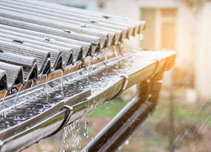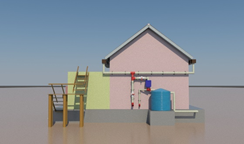Solving Water Scarcity
How Rainwater Harvesting Can Ensure Sustainable Water Management
Water is a precious resource, and its scarcity poses a significant challenge worldwide. With urban populations swelling and climate change intensifying both droughts and floods, the need for Sustainable Water Management Practices has never been more urgent. One effective solution is rainwater harvesting — a practice that captures and stores rainwater for later use. At Green Arch Associates, we are committed to promoting Rainwater Harvesting as a crucial strategy for alleviating water scarcity and enhancing Water Security in communities.
What is Rainwater Harvesting?
Rainwater harvesting is the process of collecting and storing rainwater from rooftops, land surfaces, or other catchment areas. The process typically involves several stages:
- Rainfall Collection: Water is captured from surfaces like roofs or land areas.
- Filtration: The collected water is filtered to remove debris, leaves, and other contaminants.
- Storage: The filtered water is stored in tanks for various uses, such as irrigation, drinking, or domestic needs.
By Capturing Rainwater, we reduce reliance on conventional water sources, contributing to Sustainable Water Management and reducing water scarcity.

According to the United Nations, over 2 billion people worldwide live in countries experiencing high water stress. Urbanization, population growth, and climate change are exacerbating the problem. In India, nearly 600 million people face extreme water scarcity. This highlights the urgent need for innovative solutions, such as rainwater harvesting, to ensure water availability for future generations.

How Rainwater Harvesting Helps Address Water Scarcity
1. Resource Conservation
By capturing rainwater, we reduce the demand on conventional groundwater and surface water sources. This practice helps replenish aquifers and maintains the ecological balance of local water systems. For instance, rainwater harvesting in drought-prone regions can support agriculture and drinking water needs during dry spells.

2. Flood Mitigation
Rainwater harvesting systems can help manage Stormwater runoff, reducing the risk of urban flooding. These systems direct rainwater to storage tanks or allow it to infiltrate the ground, preventing erosion and water pollution. In cities like Chennai and Mumbai, such systems have significantly reduced flooding during heavy rains, protecting both property and public infrastructure.

3. Cost Savings
Using harvested rainwater can lead to lower water bills for households and businesses. In some regions, rainwater harvesting has helped reduce dependence on municipal water supplies, leading to savings of up to 50% in water-related expenses annually

Types of Rainwater Harvesting Systems
Rainwater harvesting systems vary based on location and needs. Here are some of the most common methods:
- Rooftop Rainwater Harvesting: The most widespread method, where rainwater is collected from roofs and directed into storage tanks.

- Surface Runoff Harvesting: Involves capturing rainwater from open land surfaces, such as fields and roads, and channelling it into storage through trenches or bunds

Infiltration Pits/recharge borewell: These pits allow rainwater to percolate into the ground, recharging the Groundwater Table and preventing runoff. Infiltration pits are particularly beneficial in areas where groundwater depletion is a concern.

Join Us
Explore how our initiatives are making a difference and how you can get involved in fostering a sustainable future.
